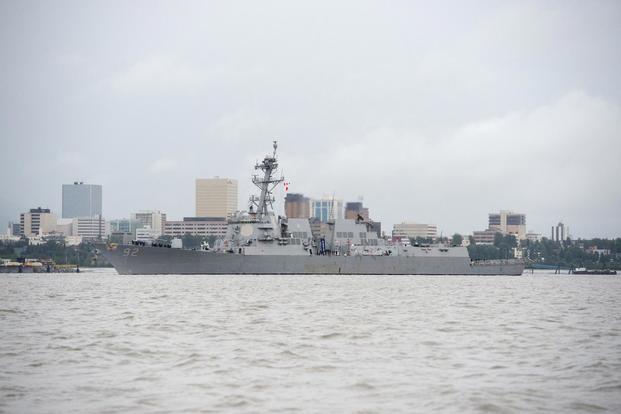PORT OF ANCHORAGE, Alaska -- Just 20 U.S. sailors are currently stationed in Alaska. But thanks to a shift in how the U.S. is thinking about Arctic defense, that could be about to change.
That, at least, is what this week's first-ever Arctic Maritime Symposium aims to explore, said Navy Capt. Layne McDowell, who directs plans, policy and resources for North American Aerospace Defense Command's (NORAD) Alaska region.
"There's just right now not a lot of [Defense Department] effort that's focused on the Arctic," he said.
This week, Navy leaders are meeting with experts to explore how that should change. With Russia and China as international neighbors and a primary focus of the Pentagon's current defense strategy, officials are thinking through ways to leverage Alaska's vast yet inhospitable territory.
That could mean stationing more sailors in Alaska and increasing the service's Arctic surface capabilities, McDowell said.
The Arctic Maritime Symposium was convened this week at Joint Base Elmendorf-Richardson (JBER) to explore the logistics and "strategic challenges" of that subject. McDowell's small office of about 10 people -- some uniformed, some civilian -- worked with Alaskan Command's operations section to put together the three-day event, which ends Aug. 16.
Led by the Navy, the symposium pulled in experts from multiple U.S. agencies, as well as Army, Air Force and Coast Guard representatives and international partners.
If Arctic defense is important, the Navy needs to figure out how to train for it and operate in it, McDowell said. And that's going to take not just adding vessels to the surface fleet that can handle the rigors of cold and ice, but increasing the service's role in exercises and perhaps basing more sailors in the region.
"What we're trying to do at the symposium is we're looking five to 10 years out to strategically see what the Navy's role in exercises should be," he said.
The service needs ships designed not just to break ice, but to withstand the extra stress ice can cause on weight and balance, for example.
"First, we need to set the requirements for ship acquisition," McDowell said. He spoke with Military.com while standing on a dock here next to the USS Momsen, an Arleigh Burke-class destroyer in port for the event, which is being hosted just a few miles away. Some of the symposium's 130 participants will tour the vessel before it departs Aug. 17.
The ship offers a good example of a vessel that can handle some ice, thanks in part to its reinforced hull, said its commanding officer, Cmdr. Elaine Brunelle.
Although the Coast Guard has a significant presence in Alaska, Navy vessels rarely visit the Port of Anchorage. Officials said they didn't readily know the last time a port call was made here.
The state has hosted all three military service secretaries as well as the Coast Guard commandant over the last two weeks. And while Coast Guard officials visit regularly, the Army, Navy and Air Force secretaries do not.
During a press conference just off the Momsen, Air Force Col. Mark Schmidt, who heads operations for Alaskan Command at JBER, said those official visits were made as part of an attempt to better understand the Arctic.
"A lot of your higher-profile [visitors] are just trying to understand and learn the environment," he said. "Their understanding and their knowledge is important for Alaska but [also] America, because we are an Arctic nation thanks to Alaska. "
Any effort to expand the Navy's or other services' presence in the Arctic will require a funding increase, an ever tricky subject. For example, although the authorization to buy six new ice breakers to add to the Coast Guard's current, ageing fleet of two was included in the 2019 National Defense Authorization Act signed by President Donald Trump on Aug. 13, the cash to actually buy them is in limbo in separate legislation.
But McDowell said funding is a question for a later time. For now, officials are focusing on the plug-and-play opportunities both for exercises in Alaska's waters and Navy and Marine training. As part of that, Navy Secretary Richard V. Spencer on Aug. 13 visited Nome, a remote port town strategically placed in the Norton Sound of the Bering Sea.
"We think he's the first secretary ever to visit Nome," McDowell said. "What he's looking at is what existing facilities he can plug into for the near term."
-- Amy Bushatz can be reached at amy.bushatz@military.com.












